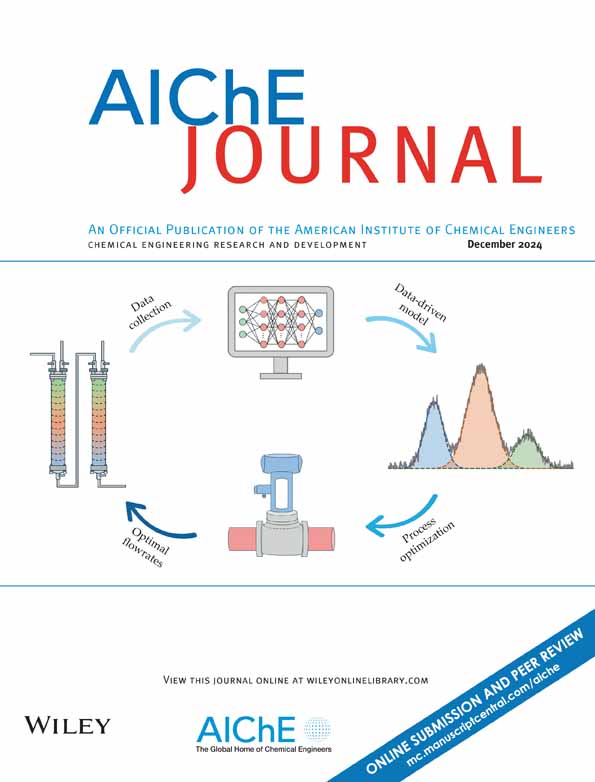量子力学纳米反应器模拟揭示PVC热解途径
IF 3.5
3区 工程技术
Q2 ENGINEERING, CHEMICAL
引用次数: 0
摘要
热解在无氧条件下将大分子转化为更小的碎片,为合成聚合物的回收提供了一个很有前途的平台。这个复杂的化学网络包含了数百种反应,随着过程的展开,产生了数百种分子和自由基。本文采用纳米反应器分子动力学模拟和最先进的半经验方法GFN-xTB研究了聚氯乙烯(PVC)的热解机理。我们的模拟揭示了一个复杂的反应网络,突出了两个竞争性的、能量有利的氯消除途径:1,2消除和Cl·自由基引发的氢提取,挑战了传统的Cl/H·自由基耦合机制。HCl消除生成共轭烯烃,随后芳构化,而氢提取形成碳氢自由基促进环化。纳米反应器模拟,由高转移性的量子力学方法驱动,能够自主和公正地发现复杂化学过程的反应机制,超越传统方法依赖于从化学直觉推断的途径的局限性。本文章由计算机程序翻译,如有差异,请以英文原文为准。
Quantum mechanical nanoreactor simulations reveal PVC pyrolysis pathways
Pyrolysis, which converts macromolecules into smaller fragments in the absence of oxygen, offers a promising platform for synthetic polymer recycling. This sophisticated chemical network encompasses hundreds of reactions, yielding hundreds of molecular species and radicals as the process unfolds. We investigate the pyrolysis mechanism of polyvinyl chloride (PVC) using nanoreactor molecular dynamics simulations in tandem with the state-of-the-art semi-empirical method GFN-xTB. Our simulations reveal a complex reaction network, highlighting two competitive, energetically favorable chlorine elimination pathways: 1,2-elimination and Cl· radical-initiated hydrogen abstraction, challenging the conventional Cl/H· radical coupling mechanism. HCl elimination yields conjugated olefins, subsequently aromatizing, while hydrogen abstraction forms hydrocarbon radicals promoting cyclization. Nanoreactor simulations, driven by quantum mechanical methods of high transferability, enable the autonomous and unbiased discovery of reaction mechanisms of complex chemical processes, transcending the limitations of traditional methods that rely on pathways deduced from chemical intuition.
求助全文
通过发布文献求助,成功后即可免费获取论文全文。
去求助
来源期刊

AIChE Journal
工程技术-工程:化工
CiteScore
7.10
自引率
10.80%
发文量
411
审稿时长
3.6 months
期刊介绍:
The AIChE Journal is the premier research monthly in chemical engineering and related fields. This peer-reviewed and broad-based journal reports on the most important and latest technological advances in core areas of chemical engineering as well as in other relevant engineering disciplines. To keep abreast with the progressive outlook of the profession, the Journal has been expanding the scope of its editorial contents to include such fast developing areas as biotechnology, electrochemical engineering, and environmental engineering.
The AIChE Journal is indeed the global communications vehicle for the world-renowned researchers to exchange top-notch research findings with one another. Subscribing to the AIChE Journal is like having immediate access to nine topical journals in the field.
Articles are categorized according to the following topical areas:
Biomolecular Engineering, Bioengineering, Biochemicals, Biofuels, and Food
Inorganic Materials: Synthesis and Processing
Particle Technology and Fluidization
Process Systems Engineering
Reaction Engineering, Kinetics and Catalysis
Separations: Materials, Devices and Processes
Soft Materials: Synthesis, Processing and Products
Thermodynamics and Molecular-Scale Phenomena
Transport Phenomena and Fluid Mechanics.
 求助内容:
求助内容: 应助结果提醒方式:
应助结果提醒方式:


